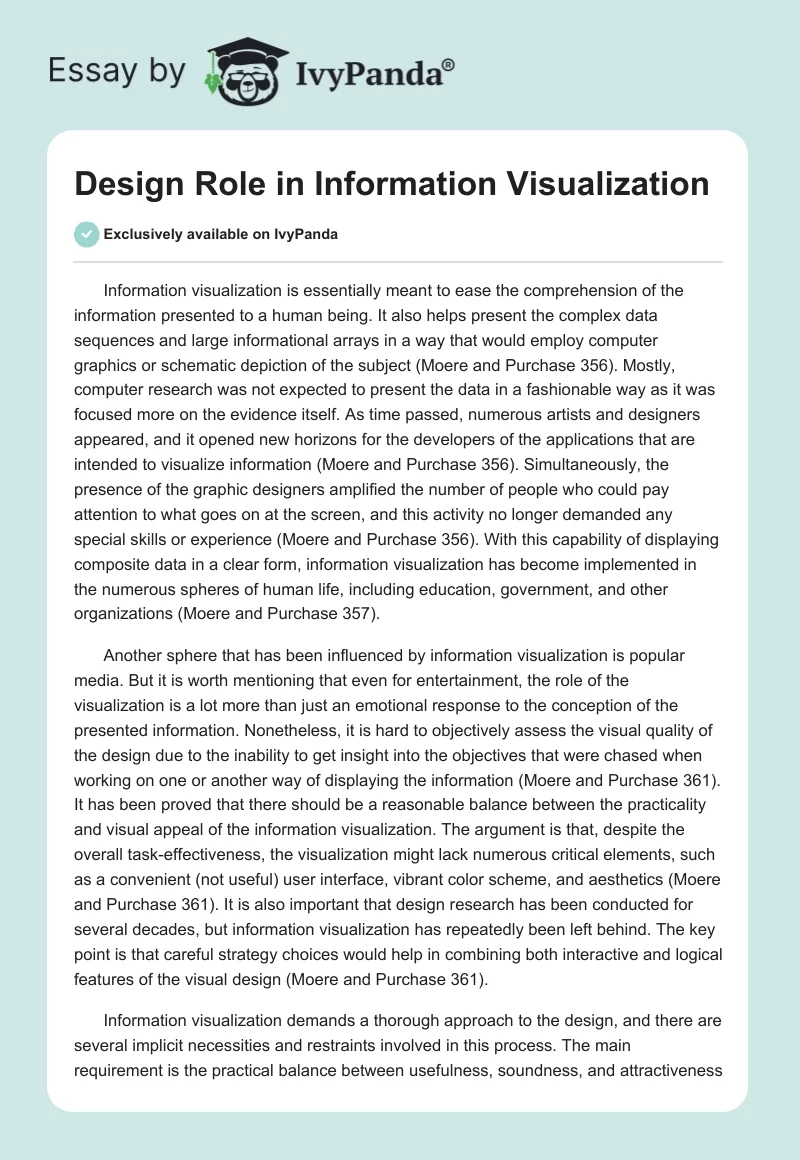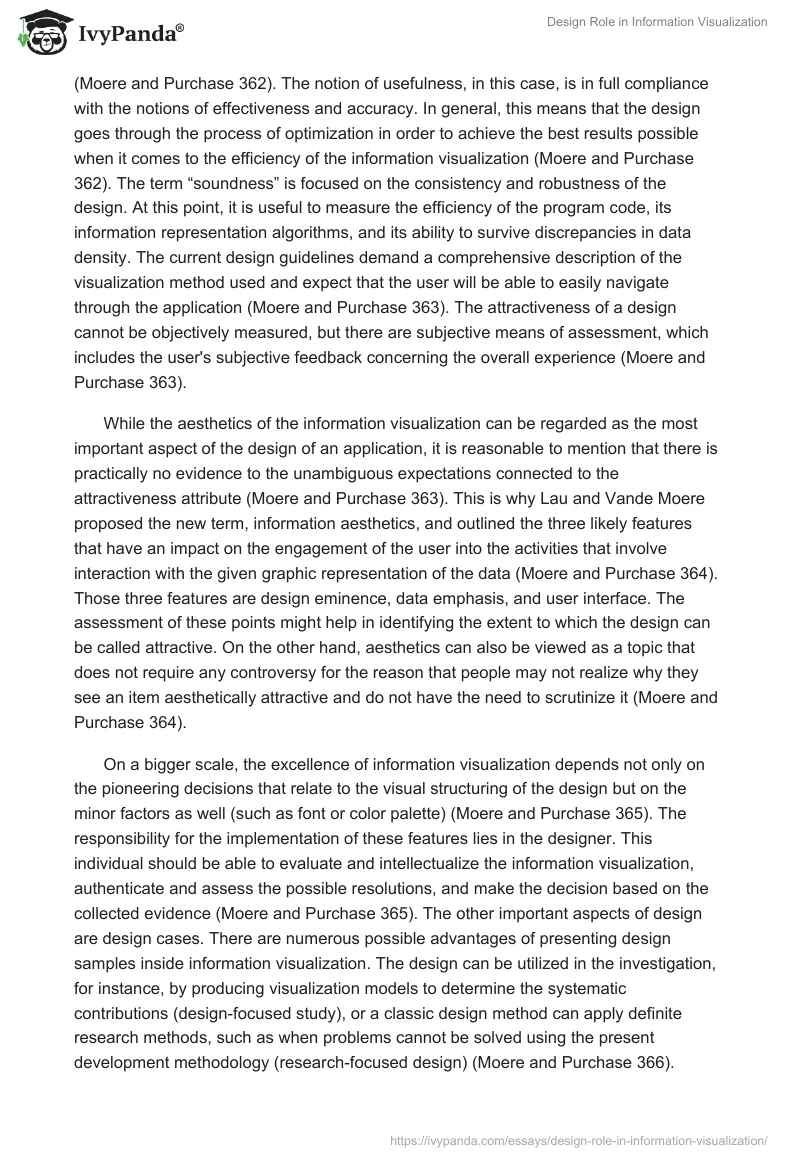Information visualization is essentially meant to ease the comprehension of the information presented to a human being. It also helps present the complex data sequences and large informational arrays in a way that would employ computer graphics or schematic depiction of the subject (Moere and Purchase 356). Mostly, computer research was not expected to present the data in a fashionable way as it was focused more on the evidence itself. As time passed, numerous artists and designers appeared, and it opened new horizons for the developers of the applications that are intended to visualize information (Moere and Purchase 356). Simultaneously, the presence of the graphic designers amplified the number of people who could pay attention to what goes on at the screen, and this activity no longer demanded any special skills or experience (Moere and Purchase 356). With this capability of displaying composite data in a clear form, information visualization has become implemented in the numerous spheres of human life, including education, government, and other organizations (Moere and Purchase 357).
Another sphere that has been influenced by information visualization is popular media. But it is worth mentioning that even for entertainment, the role of the visualization is a lot more than just an emotional response to the conception of the presented information. Nonetheless, it is hard to objectively assess the visual quality of the design due to the inability to get insight into the objectives that were chased when working on one or another way of displaying the information (Moere and Purchase 361). It has been proved that there should be a reasonable balance between the practicality and visual appeal of the information visualization. The argument is that, despite the overall task-effectiveness, the visualization might lack numerous critical elements, such as a convenient (not useful) user interface, vibrant color scheme, and aesthetics (Moere and Purchase 361). It is also important that design research has been conducted for several decades, but information visualization has repeatedly been left behind. The key point is that careful strategy choices would help in combining both interactive and logical features of the visual design (Moere and Purchase 361).
Information visualization demands a thorough approach to the design, and there are several implicit necessities and restraints involved in this process. The main requirement is the practical balance between usefulness, soundness, and attractiveness (Moere and Purchase 362). The notion of usefulness, in this case, is in full compliance with the notions of effectiveness and accuracy. In general, this means that the design goes through the process of optimization in order to achieve the best results possible when it comes to the efficiency of the information visualization (Moere and Purchase 362). The term “soundness” is focused on the consistency and robustness of the design. At this point, it is useful to measure the efficiency of the program code, its information representation algorithms, and its ability to survive discrepancies in data density. The current design guidelines demand a comprehensive description of the visualization method used and expect that the user will be able to easily navigate through the application (Moere and Purchase 363). The attractiveness of a design cannot be objectively measured, but there are subjective means of assessment, which includes the user’s subjective feedback concerning the overall experience (Moere and Purchase 363).
While the aesthetics of the information visualization can be regarded as the most important aspect of the design of an application, it is reasonable to mention that there is practically no evidence to the unambiguous expectations connected to the attractiveness attribute (Moere and Purchase 363). This is why Lau and Vande Moere proposed the new term, information aesthetics, and outlined the three likely features that have an impact on the engagement of the user into the activities that involve interaction with the given graphic representation of the data (Moere and Purchase 364). Those three features are design eminence, data emphasis, and user interface. The assessment of these points might help in identifying the extent to which the design can be called attractive. On the other hand, aesthetics can also be viewed as a topic that does not require any controversy for the reason that people may not realize why they see an item aesthetically attractive and do not have the need to scrutinize it (Moere and Purchase 364).
On a bigger scale, the excellence of information visualization depends not only on the pioneering decisions that relate to the visual structuring of the design but on the minor factors as well (such as font or color palette) (Moere and Purchase 365). The responsibility for the implementation of these features lies in the designer. This individual should be able to evaluate and intellectualize the information visualization, authenticate and assess the possible resolutions, and make the decision based on the collected evidence (Moere and Purchase 365). The other important aspects of design are design cases. There are numerous possible advantages of presenting design samples inside information visualization. The design can be utilized in the investigation, for instance, by producing visualization models to determine the systematic contributions (design-focused study), or a classic design method can apply definite research methods, such as when problems cannot be solved using the present development methodology (research-focused design) (Moere and Purchase 366).
The area of visualization studies bears a resemblance to archetypal theoretical investigation activities similar to a methodical analysis, the objective of which is to complement expressive and empirically confirmed perceptions to a comprehensive form of knowledge (Moere and Purchase 367). Its key objectives are to recognize, explicate, and foresee. The amalgamation of its historical setting in information technology and the utilization of high-level application spheres means the scientific investigation community has inclined to concentrate on the usefulness and soundness in conception, principally ignoring the importance of attractiveness (Moere and Purchase 367). A visualization designer may even realize the design development to be the aim of the hypothetical research. Nevertheless, a change in research emphasis from an examination of present information visualization practices to the distribution of original concepts that aim for replication and modification in approach may necessitate a noteworthy model shift in how the domain is professed and how the study is conducted (Moere and Purchase 368).
Although the events within the three fields might seem comparable in some real life circumstances, it is beneficial to distinguish their alterations with the intention of accepting design as a cross-disciplinary study that can enable the distribution of respected knowledge. All three areas generate numerous categories of information visualization, each from its own exclusive viewpoint (Moere and Purchase 368). The authors of the article believe that the modernization will transpire in the center of the triangle, where the three areas interconnect.
Work Cited
Moere, A., and H. Purchase. “On the Role of Design in Information Visualization.” Information Visualization 10.4 (2011): 356-71. Web.


